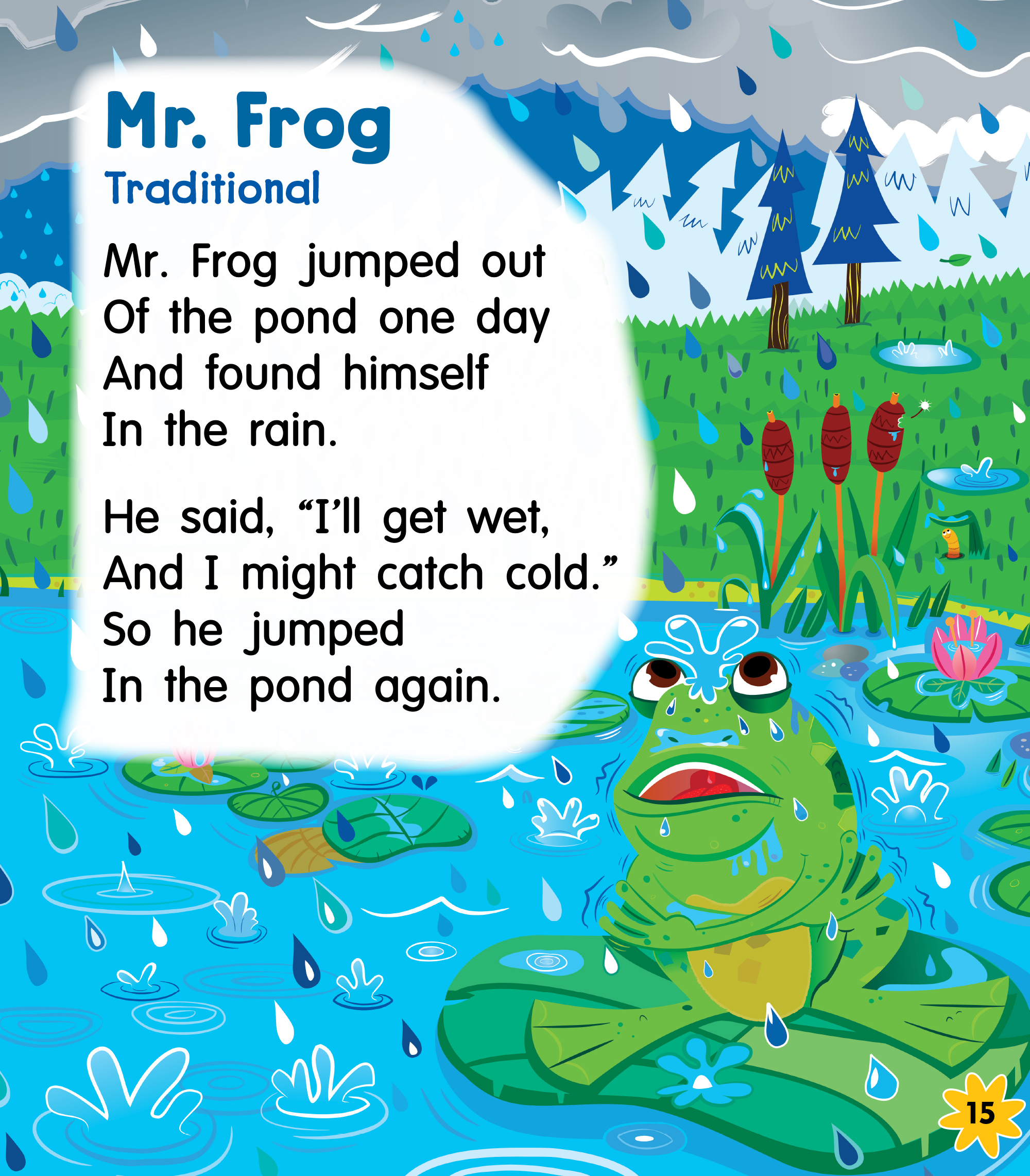Illustrated by David Sones
Text Type: Fiction: Poetry—nonsense song/poem
Oral Language Teaching Strategy: Encourage Partner Talk Encourage students to talk through their ideas with a partner before sharing their ideas with the group.
Time: 20 minutes
Materials:
– All Together Now, page 15
– frog puppet
– Media Key or Online: “Mr. Frog” audio
Grouping: whole class and partners
Assessment: Kindergarten Oral Language Assessment Scale See especially the section on Phonological and Phonemic Awareness.
FIRST READING
BEFORE SINGING AND READING
- Note that you may wish to lead into this lesson by revisiting “The Frog Song” from pages 8-9, if you have already shared that poem with students.
-
Hello everybody! I’m Mr. Frog. This is a picture of me at the pond where I live. I have a song to share with you today.
Show students the double-page illustration that includes the words to the song. Tell them that they will be learning a song about a frog called “Mr. Frog.”
- Wear the frog puppet and use it to introduce and accompany the lesson. Introduce the topic with the puppet and let it peep over or around the side of the big book.
Activating and Building Background Knowledge
-
Tell your partner something you already know about frogs, such as where they live, how they move, and what they eat.
Using the puppet, ask the students to tell an elbow partner what they already know about frogs. Use the illustrations to stimulate ideas. Ask some students to share their ideas with the class. [Making connections]
- Use the illustration as a support for a discussion about frogs. In your discussion, try to elicit vocabulary found in the song, such as ‘jump,’ ‘pond,’ ‘wet,’ ‘rain,’ and ‘cold.’
Teacher: Look at the frog sitting on the lily pad. How do you think he got there?
Teacher: Yes, you’re right… frogs jump. That’s probably how he got there. -
It’s important to share our ideas with a partner because it helps us to clarify our ideas before we share with the group.
As you listen to the students discuss with a partner and then share ideas with the class, emphasize the importance of sharing ideas with a partner.
-
I remember hugging myself like that when I was waiting for the bus one day. It was cold and I felt a bit warmer when I held my arms like that. Tell a partner about a time that you hugged yourself and why.
Point to the illustration of the frog and tell students that he looks like he has his arms wrapped around him, as though he is hugging himself. Demonstrate giving yourself a hug, and ask students to copy you. Tell students about a time that you hugged yourself like this to keep warm and encourage students to share their own experiences with an elbow partner.
Setting a Purpose
-
Join in singing with me as soon as you like. As you listen and sing along, think about why I’m jumping in and out of the pond.
Use the puppet to tell the students that you are going to play the song for them and that they should listen and join in as soon as they like. Ask them to think about why the frog jumps in and then out of the pond. [Inferring]
DURING SINGING AND READING
- Play the song and use the puppet to encourage singing along, especially when the song is sung a second and third time. Gently bounce the puppet on your lap to the beat as the music plays.
- Focus on comprehension by offering prompts:
- How did Mr. Frog get out of the pond? [Analyzing]
- How did he know it was raining? [Inferring]
- Did he like being out in the rain? How do you know? [Analyzing/inferring]
- What did he do then? [Analyzing]
- Why do you think he has his arms wrapped around himself? [Inferring]
- Why did he jump back in the pond? [Inferring]
- What is funny about the frog jumping back into the pond? (that he’ll still be wet and cold) [Inferring]
Adding Playful Movements
- Replay the song and model Mr. Frogs’ actions for students, encouraging them to join in:
- Mr. Frog jumped out
Of the pond one day
(crouched with legs spread like a frog, jump up to one side) - And found himself
In the rain.
(hold hands up and look up at the “sky”) - He said, “I’ll get wet,
And I might catch cold.”
(shiver, wrapping your arms around you as though you’re hugging yourself) - So he jumped
In the pond again.
(crouched with legs spread like a frog, jump back to the other side again)
AFTER SINGING AND READING
-
Why was I jumping in and out of the pond in the song?
Revisit the purpose for singing and reading by using the puppet to ask students why Mr. Frog jumped in and then out of the pond. [Analyzing]
- You may wish to conclude the lesson by re-singing the song with actions and asking a student to wear the frog puppet to encourage participation.
SECOND AND FURTHER READING
The students will want to reread and re-sing “Mr. Frog.” During further lessons, consider including a balance of ideas from the following areas:
Engaging in Playful Language Activities
- Have the students sing the song using different voice styles, for example, in a low, croaking voice, in a whisper, in a high, squeaky voice, in a shivering, cold voice.
- Have the students sing the narrative parts of the song in a regular voice and then use a different voice for the frog’s speech: ‘I’ll get wet, /And I might catch cold.’
- Ask students to get into two or more lines at one end of the classroom or gymnasium to play leapfrog while you play the song. Have students leave big spaces in between themselves, then have the last student in each line leapfrog over the other students in front of her or him until she or he reaches the end of the line and crouches down. Then have the next student in line follow behind, and so on. Encourage students to sing along as they hop.
Extending Comprehension
- As the group sings along with the song version, allow individual students to take turns using the frog puppet to perform the actions described in the song.
- Ask students to brainstorm other animals and funny complaints that could be substituted for the frog and getting wet and catching cold (e.g., cat jumping into a sunny spot, complaining of getting warm and falling asleep; bird flying into the air, complaining of being too high up). Students may brainstorm in pairs, then share their ideas with the group. Then, as a group, replace appropriate words in the big book with new ones written on sticky notes, or rewrite the text on chart paper as a shared writing exercise.
- Display the digital cloze version of the text on the Media Key. Working with the whole class, or with a small group, reread together and encourage students to supply the missing words (spaces for words highlighted in yellow). You may decide to pause to consider word predictions and prompt, “Does that make sense?” or “Does that sound right?” Then click on the colour-highlighted spot to reveal the word, saying, “Let’s check that out.” An option on the tool bar allows you to create your own cloze versions of the text to meet the needs of the students you are working with. Click on the ‘Help’ button to find out how to use the different features of the digital texts.
Developing Phonological Awareness
- Replay the song and ask the students to gently tap their hands on their legs to the beat of the music, as you demonstrate.
- Do oral rhyming for the words ‘frog’ (e.g., ‘log,’ ‘bog,’ ‘jog,’ ‘hog,’ ‘cog’), ‘jump’ (e.g., ‘bump,’ ‘hump,’ ‘lump,’ ‘pump,’ ‘grump,’ ‘stump’), ‘cold’ (e.g., ‘told,’ ‘sold,’ ‘mold,’ ‘bold’), and/or ‘wet’ (e.g., ‘pet,’ ‘set,’ ‘get,’ ‘met,’ ‘let’).
Enriching Print Concepts
- Track the print as you sing and re-sing the song. Use the frog puppet to emphasize movement to a new line.
- As the song becomes more familiar, ask students to take turns in tracking the print.
- Emphasize the concept of ‘word’ by asking the students to gently drum thighs with flat hands once for each word.
- Use a word frame (e.g., Wikki Stix bent around a word, a cut-out cardboard frame, or a piece of coloured acetate) and look at selected words such as ‘jumped,’ ‘himself,’ ‘he,’ ‘again,’ ‘wet.’ Clap the number of letters in each word. Stomp feet for the syllables in the words, one stomp for each syllable. (Concepts: A word is made up of letters; some words are long, some are short; some words have one syllable, some have more.)
- Draw attention to the capital letters at the beginning of the words ‘Mr.’ and ‘Frog’ and compare them to the beginning letters of ‘might’ and ‘found.’
- Listen to the song again and note to students the different voice used for Mr. Frog’s speech. Point out the use of quotation marks in the text, noting that this text treatment indicates speech, also.
FOLLOW-UP IN CENTRES
- Place the frog puppet and big book at a centre and encourage the students to reread and re-sing the song. Provide the fluent reading and song on the Media Key or online to support students as they sing and read.
- You could include other books, poems, and images about frogs (e.g., The Big Wide-Mouthed Frog) in the library corner. Encourage students to share their experiences with frogs with other students.
- Provide a plastic toy frog at the water table and encourage students to act out the story from the song.
- Students can paint or draw pictures of frogs or create frog sculptures from modelling clay or scrap materials to share with classmates during group sharing time.

